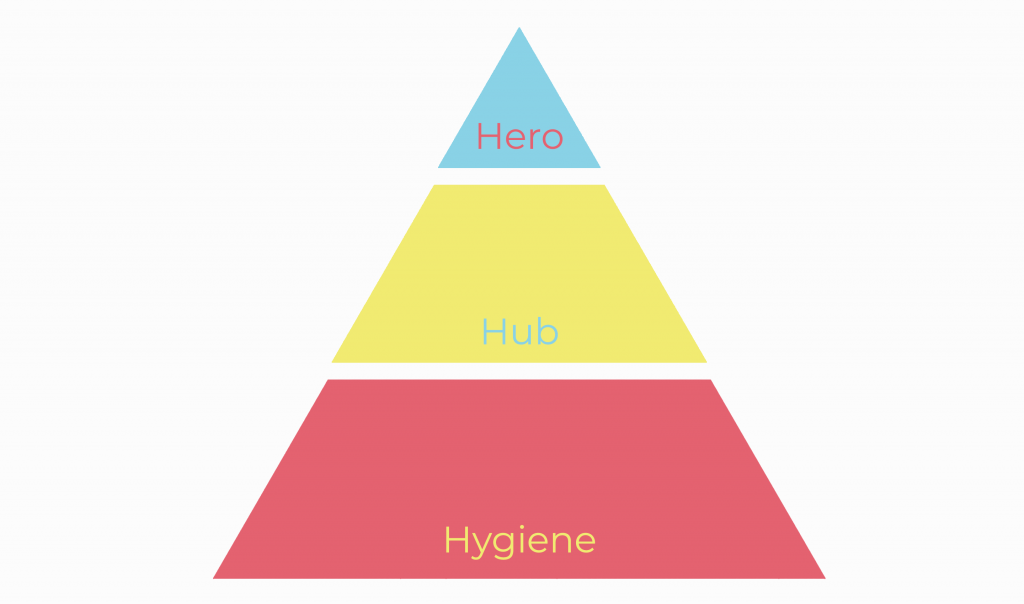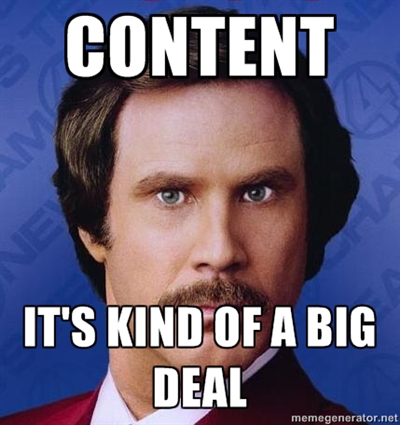From Netflix to YouTube, content forms a significant part of our daily lives – especially when it comes to entertainment. So, it is only natural that we use it for marketing purposes – it’s where our customers are. In content marketing circles, we often discuss the ‘3 H’s.’ Much like the ‘4 P’s of marketing’ (Product, Price, Place and Promotion), the ‘3 H’s’ help us build a strong content strategy for businesses large and small. So, what are they, and what value do they bring to your content marketing strategy? Hero, Hub and Hygiene This model, originally devised by Google to categorise YouTube videos, distinguishes three different types of content – Hero, Hub and Hygiene – to ensure your content hub is fulfilling the needs of your whole audience now and in the future.  Hero content makes up your star articles; the high-impact pieces that wow your viewers and speak to the broadest audience, spreading brand awareness far and wide. This content type generally takes longer to create and can cost more to produce, so these pieces generally are fewer and further between. Hero content will likely be featured on your website like a beacon to entice new viewers. It can come in the form of videos with impressive production values, quizzes, whitepapers and interactive platforms or apps. Key purpose: to bolster the number of new visitors you see across your site. Hub content is your regular, run of the mill content. Themes will cover what you talk about daily in your industry and can cross a wide range of related topics but will pinpoint a much more specific audience; a fragment of your broader target market. This content is what keeps your site fresh and your audience returning for more. By finding out what your audience wants to know, you can start developing hub content that whets their appetite by providing detail on the finer aspects of your specialty. Hub content can come in the form of blogs, partnerships, case studies and PR articles. Key purpose: to ensure previous visitors return to your site. Hygiene content is evergreen. By this, we mean that, no matter how long it sits on your site, it remains relevant to your audience. The primary purpose of hygiene content is to help your viewer base through education. It won’t necessarily stand out from the crowd but is always there for you to fall back on, providing critical functional value to regular and new visitors alike. Often used as the primary format for SEO blogs, hub content will hit the long-tail keywords your prospective clients are searching for and provide answers to the questions they are asking. These content pieces can come in the form of how-to guides, tips & tricks and tutorials. Key purpose: to get you seen in search engine and improve the traffic on your site. The Hero-Hub-Hygiene Pyramid So, now you know what the ‘3 H’s’ are and can start to think more specifically about how you can use them. But, wait – there’s more! These ‘3 H’s’ actually fall neatly into a pyramid that guides you as to how often you should be publishing. See below.
Hero content makes up your star articles; the high-impact pieces that wow your viewers and speak to the broadest audience, spreading brand awareness far and wide. This content type generally takes longer to create and can cost more to produce, so these pieces generally are fewer and further between. Hero content will likely be featured on your website like a beacon to entice new viewers. It can come in the form of videos with impressive production values, quizzes, whitepapers and interactive platforms or apps. Key purpose: to bolster the number of new visitors you see across your site. Hub content is your regular, run of the mill content. Themes will cover what you talk about daily in your industry and can cross a wide range of related topics but will pinpoint a much more specific audience; a fragment of your broader target market. This content is what keeps your site fresh and your audience returning for more. By finding out what your audience wants to know, you can start developing hub content that whets their appetite by providing detail on the finer aspects of your specialty. Hub content can come in the form of blogs, partnerships, case studies and PR articles. Key purpose: to ensure previous visitors return to your site. Hygiene content is evergreen. By this, we mean that, no matter how long it sits on your site, it remains relevant to your audience. The primary purpose of hygiene content is to help your viewer base through education. It won’t necessarily stand out from the crowd but is always there for you to fall back on, providing critical functional value to regular and new visitors alike. Often used as the primary format for SEO blogs, hub content will hit the long-tail keywords your prospective clients are searching for and provide answers to the questions they are asking. These content pieces can come in the form of how-to guides, tips & tricks and tutorials. Key purpose: to get you seen in search engine and improve the traffic on your site. The Hero-Hub-Hygiene Pyramid So, now you know what the ‘3 H’s’ are and can start to think more specifically about how you can use them. But, wait – there’s more! These ‘3 H’s’ actually fall neatly into a pyramid that guides you as to how often you should be publishing. See below.  As you can see, your hero content sits at the top and is the least frequent of the three types of content. This is primarily because of the time it takes, and the higher costs associated with its production. Next comes your hub content. This keeps your site bubbling away with new ideas and engages your repeat visitors. You should be producing more hub content than hero content but not as much as hygiene content. Finally, your hygiene content forms the solid base of your content strategy. You should be producing hygiene content frequently. For medium sized businesses, we suggest you publish at least once a week. This will keep you at the front of Google’s proverbial mind and improve your search engine rankings in the long term. So, how can I incorporate Hero, Hub and Hygiene content into my strategy? You probably already have some (or all) of these content types in your catalogue without knowing it. However, by planning ahead and identifying the specific purpose (or category) of each piece, you can start to use each type to your advantage. When you plan out your content, specify how many of each content type you will develop and publish. Then, set realistic deadlines for each. Plan topics, schedule in advance and stick as closely to that schedule as you can. Content production can be time consuming for small businesses, especially if it doesn’t come naturally to you. If you need help to develop a strategy and stick to it, WME provide content marketing services that ensure your business is making the most of this popular advertising stream. Get in touch with a Webcentral Digital Strategist today to see how we can help you produce quality content and start seeing results.
As you can see, your hero content sits at the top and is the least frequent of the three types of content. This is primarily because of the time it takes, and the higher costs associated with its production. Next comes your hub content. This keeps your site bubbling away with new ideas and engages your repeat visitors. You should be producing more hub content than hero content but not as much as hygiene content. Finally, your hygiene content forms the solid base of your content strategy. You should be producing hygiene content frequently. For medium sized businesses, we suggest you publish at least once a week. This will keep you at the front of Google’s proverbial mind and improve your search engine rankings in the long term. So, how can I incorporate Hero, Hub and Hygiene content into my strategy? You probably already have some (or all) of these content types in your catalogue without knowing it. However, by planning ahead and identifying the specific purpose (or category) of each piece, you can start to use each type to your advantage. When you plan out your content, specify how many of each content type you will develop and publish. Then, set realistic deadlines for each. Plan topics, schedule in advance and stick as closely to that schedule as you can. Content production can be time consuming for small businesses, especially if it doesn’t come naturally to you. If you need help to develop a strategy and stick to it, WME provide content marketing services that ensure your business is making the most of this popular advertising stream. Get in touch with a Webcentral Digital Strategist today to see how we can help you produce quality content and start seeing results.




